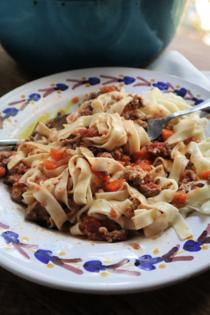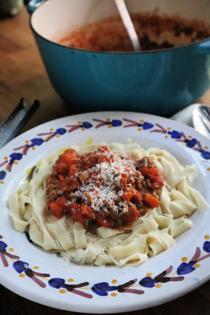Gretchen's table: Invigorate your fall senses with fresh pasta in Bolognese sauce
Published in Variety Menu
When it comes to choosing an Italian meat sauce to top a plate of homemade pasta, nothing beats a simmering pot of Bolognese.
And nobody does it better than Italian cooking teacher and cookbook writer Marcella Hazan, who is credited with introducing Americans to the techniques of traditional Italian cooking.
"Essentials of Classic Italian Cooking," which was re-released on the cookbook's 30th anniversary in 2022, should be on every cook's bookshelf because its recipes are incredibly descriptive and no-nonsense. They're easy to follow and often require very simple ingredients.
Which brings us back to her Bolognese. This slow-cooked ragu (meat sauce) — typically made with minced meat, onions and tomatoes — has roots in the late 1800s and the city of Bologna in northern Italy. It also includes milk (added after the meat has been browned), which both tenderizes the meat and adds a rich flavor to the finished sauce.
I used equal amounts of ground pork and beef, and canned San Marzano tomatoes. Don't be intimidated by the pasta recipe; it's both easy and foolproof. But don't sweat it if you'd rather use packaged pasta.
One note: A good Bolognese sauce can't be rushed! It needs to simmer over low heat for at least 3 hours on the stove for all the wonderful flavors to meld and concentrate. If you're in a hurry, wait until you have a lazy weekend afternoon where you're stuck inside because of bad weather or watching a football game.
In Italy, Bolognese sauce is traditionally served with a flat, ribbon-like pasta like tagliatelle. I served it on slightly wider fettuccine because the cutter attachment on my pasta roller only has two settings: fettuccine or much thinner spaghetti. But honestly, the sauce is so good any pasta will do.
Marcella Hazan's Bolognese with Fresh Pasta
PG tested
For Bolognese sauce
1 tablespoon vegetable oil
3 tablespoons butter plus 1 tablespoon for tossing the pasta
1/2 cup chopped onion
2/3 cup chopped celery
2/3 cup chopped carrot
3/4 pound ground beef chuck (or mix 1 part pork to 2 parts beef)
Salt
Black pepper, ground fresh from the mill
1 cup whole milk
Whole nutmeg
1 cup dry white wine
1 1/2 cups canned imported Italian plum tomatoes, cut up, with their juice
For pasta
2 1/4 cup all-purpose flour
4 eggs
For serving
Freshly grated Parmigiano-Reggiano cheese, for the table
Prepare sauce: Put oil, butter and chopped onion in the pot and turn the heat on medium. Cook and stir until the onion has become translucent, then add chopped celery and carrot. Cook for about 2 minutes, stirring vegetables to coat them well.
Add ground beef and/or pork, a large pinch of salt and a few grinds of pepper. Crumble the meat with a fork, stir well and cook until it has lost its raw, red color.
Add milk and let it simmer gently, stirring frequently, until it has bubbled away completely. Add a tiny grating — about 1/8 teaspoon — of nutmeg, and stir.
Add wine, let it simmer until it has evaporated, then add tomatoes and stir thoroughly to coat all ingredients well. When it begins to bubble, turn the heat down so it cooks at the laziest of simmers, with just an intermittent bubble breaking the surface.
Cook, uncovered, for 3 hours or more, stirring from time to time.
While the sauce is cooking, it may begin to dry out as the fat separates. To keep it from sticking, add 1/2 cup of water whenever necessary. At the end, however, no water must be left and the fat must separate from the sauce. Stir to mix the fat into the sauce, taste and add salt if needed.
While sauce is cooking, prepare pasta: Combine flour and eggs in bowl of a standing mixer fitted with a paddle attachment, and mix on low speed until a ball of dough forms. Continue to knead for 3 minutes, either by hand or in the mixer, so that the dough develops elasticity and silkiness.
Cover the ball of dough in plastic wrap and let it rest at room temperature for 30 minutes before using. Alternatively, you can let the dough rest for up to 24 hours in the refrigerator.
Using a bench scraper, divide dough into 6 equal portions. Lightly dust your work area with flour.
To roll pasta dough by hand: roll one piece into a long sheet as thin as you can get it, about 1/16th of an inch thick. (Keep rest of dough covered.) Repeat with remaining dough.
To roll pasta by machine: Pat dough into a small rectangle and dust with flour. Set pasta maker to widest setting (level 1) and pass dough through the machine at this setting 3 times. Repeat three times on level 2, three times on level 3, and one time each on levels 4, 5, and 6.
To cut dough by hand: Dust the pasta sheet on both sides with flour, then use a pasta cutter or sharp knife to cut dough into 1/2 -inch strips (fettuccine) or 1-inch strips (pappardelle). Toss noodles with your hand to separate and unfold, adding more flour if it's sticking. Set aside, covered with plastic, and continue with remaining dough.
To cut dough by machine: Run the pasta sheets through the pasta cutter, then toss noodles with flour to prevent sticking. Repeat with remaining dough.
Cook the cut pasta in a pot of salted boiling water for 1 or 2 minutes. Toss sauce with cooked, drained pasta, add a tablespoon of butter if desired, and serve with freshly grated Parmesan on the side.
Serves 4.
— "Essentials of Classic Italian Cooking: 30th Anniversary Edition" by Marcella Hazan (Knopf, $40)
©2024 PG Publishing Co. Visit at post-gazette.com. Distributed by Tribune Content Agency, LLC.













Comments